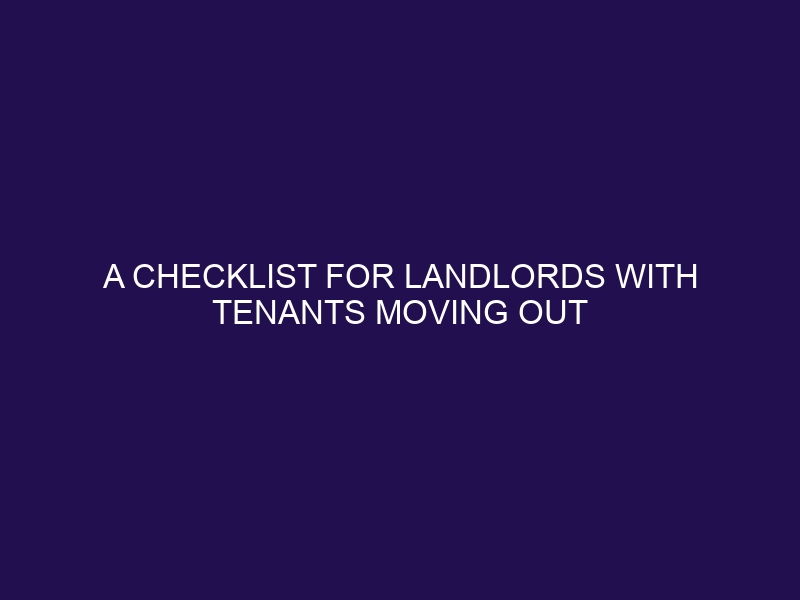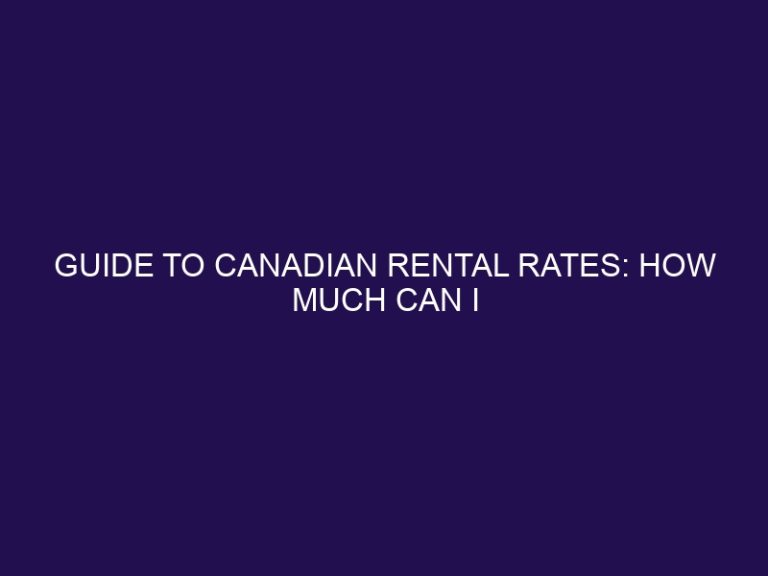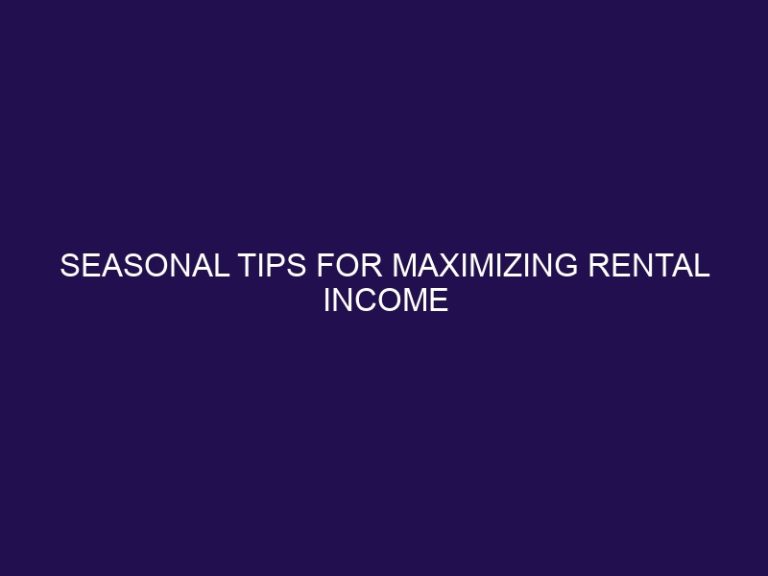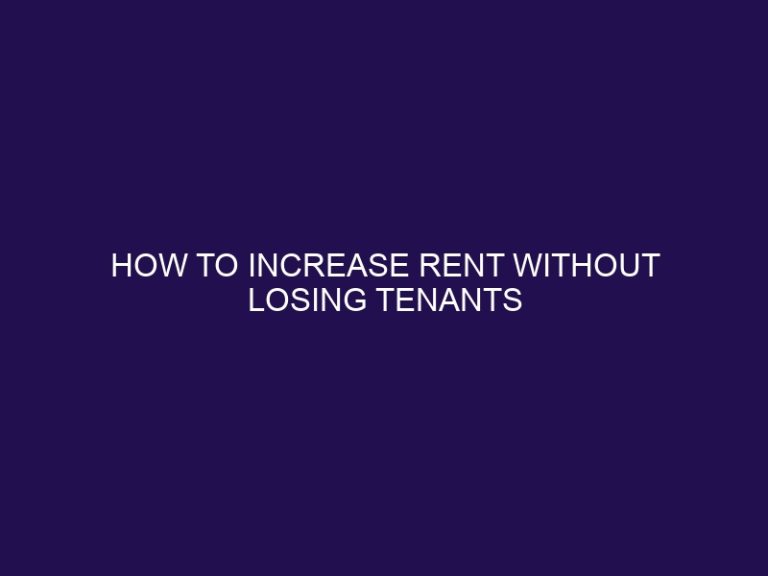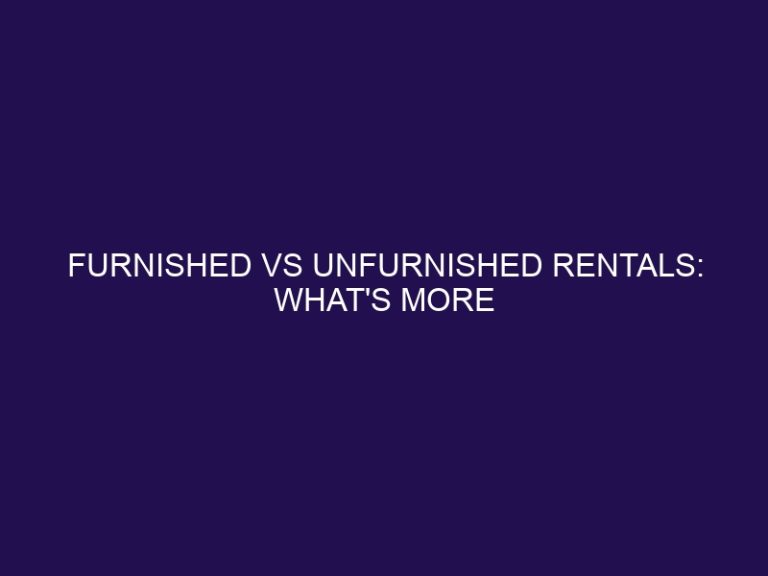A Checklist for Landlords With Tenants Moving Out
As a landlord, it is important to have a checklist in place for when a tenant moves out of your property. This ensures that the transition process is smooth and efficient, while also protecting your rights as a landlord. Here is a comprehensive checklist for landlords with tenants who are moving out.
Before the tenant moves out, there are a few important steps that should be taken:
- Review the lease agreement: Familiarize yourself with the terms of the lease agreement and any policies regarding move-out procedures.
- Notify the tenant of move-out procedures: It is important to inform the tenant of the process and any necessary steps they need to take before moving out.
- Schedule a pre-move-out inspection: This allows you to assess the condition of the property and note any potential damages or repairs needed before the tenant moves out.
- Provide a move-out checklist: This can help the tenant ensure they have completed all necessary tasks before moving out, such as cleaning and removing personal belongings.
During the move-out process, it is important to:
- Conduct a final walk-through inspection: This is to ensure that the property is in the same condition as it was during the pre-move-out inspection.
- Document any damages or repairs needed: Take photos and notes of any damages or repairs needed, and discuss with the tenant if necessary.
- Collect keys and return security deposit: Once the tenant has returned all keys and the property is in good condition, the security deposit should be returned according to the terms of the lease agreement.
After the tenant has moved out, there are a few final steps to take:
- Clean and prepare the property for new tenants: It is important to thoroughly clean the property and make any necessary repairs before new tenants move in.
- Send a move-out letter and itemized statement of charges: This letter should inform the tenant of any charges deducted from their security deposit, along with an itemized list of these charges.
- Update and review the rental agreement: Take this opportunity to update the rental agreement and make any necessary changes.
- Keep records and documents for future reference: It is important to keep all records and documents related to the move-out process for future reference, in case any disputes arise.
By following this checklist, landlords can ensure a smooth and efficient process when a tenant moves out, while also protecting their property and their rights.
Key Takeaways:
What to Do Before the Tenant Moves Out
As a landlord, it is important to be prepared when your tenant is moving out. Before the moving day arrives, there are several important steps to take in order to ensure a smooth transition. In this section, we will discuss what you should do before the tenant moves out. From reviewing the lease agreement to providing a move-out checklist, we will cover all the necessary preparations for a successful move-out process. So, let’s dive in and make sure you are fully prepared for your tenant’s departure.
1. Review the Lease Agreement
- Examine the Lease Agreement for lease term duration, rent amount, and any special clauses.
- Review the provisions on property condition and maintenance responsibilities.
- Ensure a clear understanding of tenant obligations and landlord rights.
Did you know? 82% of landlords experience lease violations during a tenant’s stay.
2. Notify the Tenant of Move-Out Procedures
- Inform the tenant in writing about the move-out procedures as outlined in the lease agreement.
- Provide details on cleaning, repairs, and the process for returning the security deposit.
- Include specifics on returning keys and any other requirements for a seamless move-out process.
3. Schedule a Pre-Move-Out Inspection
- Notify the tenant in advance about the scheduled pre-move-out inspection.
- Confirm the date and time for the inspection to ensure the tenant’s presence.
- Prepare the necessary documentation and checklist for the inspection.
- Thoroughly inspect the property for any damages or required repairs.
4. Provide a Move-Out Checklist
- Inspect the property for any damages or needed repairs.
- Provide the tenant with a move-out checklist detailing cleaning and repair expectations.
- Set a deadline for the tenant to complete the provided move-out checklist and return the property keys.
- Review the completed checklist and return the security deposit accordingly.
What to Do During the Move-Out Process
As a landlord, it is important to be prepared for the move-out process when tenants are leaving your property. This section will guide you through the necessary steps to take during this transition. We will discuss the importance of conducting a final walk-through inspection, documenting any damages or repairs needed, and collecting keys and returning the security deposit. By following this checklist, you can ensure a smooth and organized move-out process for both you and your tenants.
1. Conduct a Final Walk-Through Inspection
- Conduct a final walk-through inspection of the entire property for any damage or cleanliness issues.
- Thoroughly check all rooms, appliances, and fixtures for any malfunctions or signs of wear and tear.
- Take photographs or make written notes of any findings.
- Discuss any concerns with the tenant during the walkthrough.
2. Document Any Damages or Repairs Needed
- Create a detailed inspection report documenting all damages and repairs that are needed.
- Capture photographs or videos as visual evidence of the current condition of the property.
- Obtain estimates for repair costs from qualified professionals.
3. Collect Keys and Return Security Deposit
- Verify all keys, including duplicates, are collected and returned by the tenant.
- Conduct a comprehensive inspection to assess any damage or excessive wear.
- Calculate and promptly return the security deposit, deducting for any documented damages.
What to Do After the Tenant Moves Out
As a landlord, it’s important to properly handle the process of a tenant moving out. After all, this is a critical stage in maintaining your property and ensuring a smooth transition for future tenants. In this section, we will discuss the essential tasks that should be completed after a tenant has moved out. From preparing the property for new tenants to updating rental agreements and keeping records, we’ll cover everything you need to know to effectively manage this process.
1. Clean and Prepare the Property for New Tenants
- Inspect the property for any damages or necessary repairs.
- Thoroughly clean and prepare the entire property, including floors, walls, and appliances, for the new tenants.
- Ensure all utilities are in working order and ready for the new tenants.
2. Send a Move-Out Letter and Itemized Statement of Charges
- Compose a move-out letter detailing the end of tenancy and any charges.
- Include an itemized statement breaking down any deductions from the security deposit.
- Send the letter and statement via certified mail to ensure delivery and record-keeping.
During the eighteenth century, formalized landlord-tenant relationships began to emerge, shaping modern property management practices.
3. Update and Review the Rental Agreement
- Review the lease expiration date and rental terms.
- Negotiate changes if needed, considering market trends and property condition.
- Update and review the rental agreement to reflect any mutually agreed modifications, taking into account the new tenancy laws.
When my tenants were moving out, I made sure to update and review the rental agreement to ensure a smooth transition for both parties, in accordance with the new laws.
4. Keep Records and Documents for Future Reference
- Create a digital or physical file for each tenant’s documents and keep them organized for future reference.
- Organize records chronologically for easy access and reference.
- Securely store important documents, such as lease agreements, move-in/move-out inspection reports, and correspondence.
- Regularly back up digital records to prevent data loss and ensure they can be easily accessed in the future.
Frequently Asked Questions
What is a move-out checklist for landlords and tenants?
A move-out checklist is a document that outlines the tasks and procedures that need to be completed by both the landlord and tenant before the tenant moves out of the rental property. It serves as a reminder for both parties and helps to minimize disputes over security deposits.
Why is a move-out checklist important for landlords?
A move-out checklist is important for landlords because it helps them to stay organized and properly document the condition of the rental unit before the tenant moves out. This protects the landlord’s property and helps to ensure a smooth transition between tenants.
What should be included in a move-out checklist?
A move-out checklist should include tasks such as scheduling an inspection, cleaning the apartment, and returning the property to its original state as stated in the lease agreement. It should also include instructions for returning keys and providing a forwarding address for the security deposit.
Is it necessary for landlords to conduct a final inspection with the tenant present?
It is recommended for landlords to conduct a final inspection with the tenant present. This allows both parties to address any issues and document the condition of the property. It also helps to avoid misunderstandings and disputes over property damage.
Are there any specific requirements for move-out procedures in certain states?
Yes, landlords should always check local landlord/tenant laws for any specific requirements regarding move-out procedures. This ensures that the landlord is following all necessary procedures and protects them from potential legal issues.
Can a move-out checklist be customized to meet the specific needs of the property?
Yes, a move-out checklist can be customized to meet the specific needs of the property. Landlords can choose to break down the checklist by room or provide general terms. This allows the checklist to be tailored to the individual property and its unique requirements.

